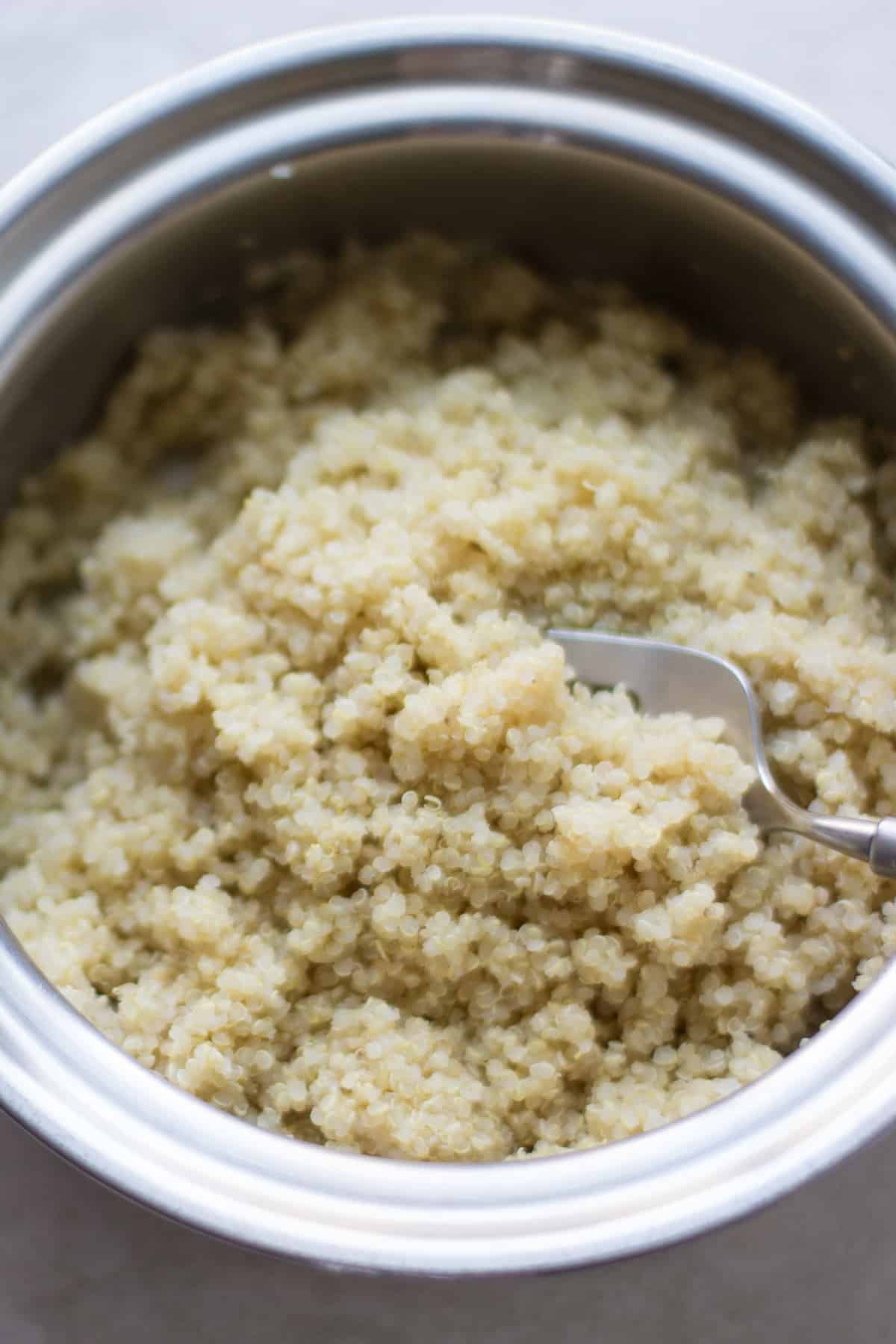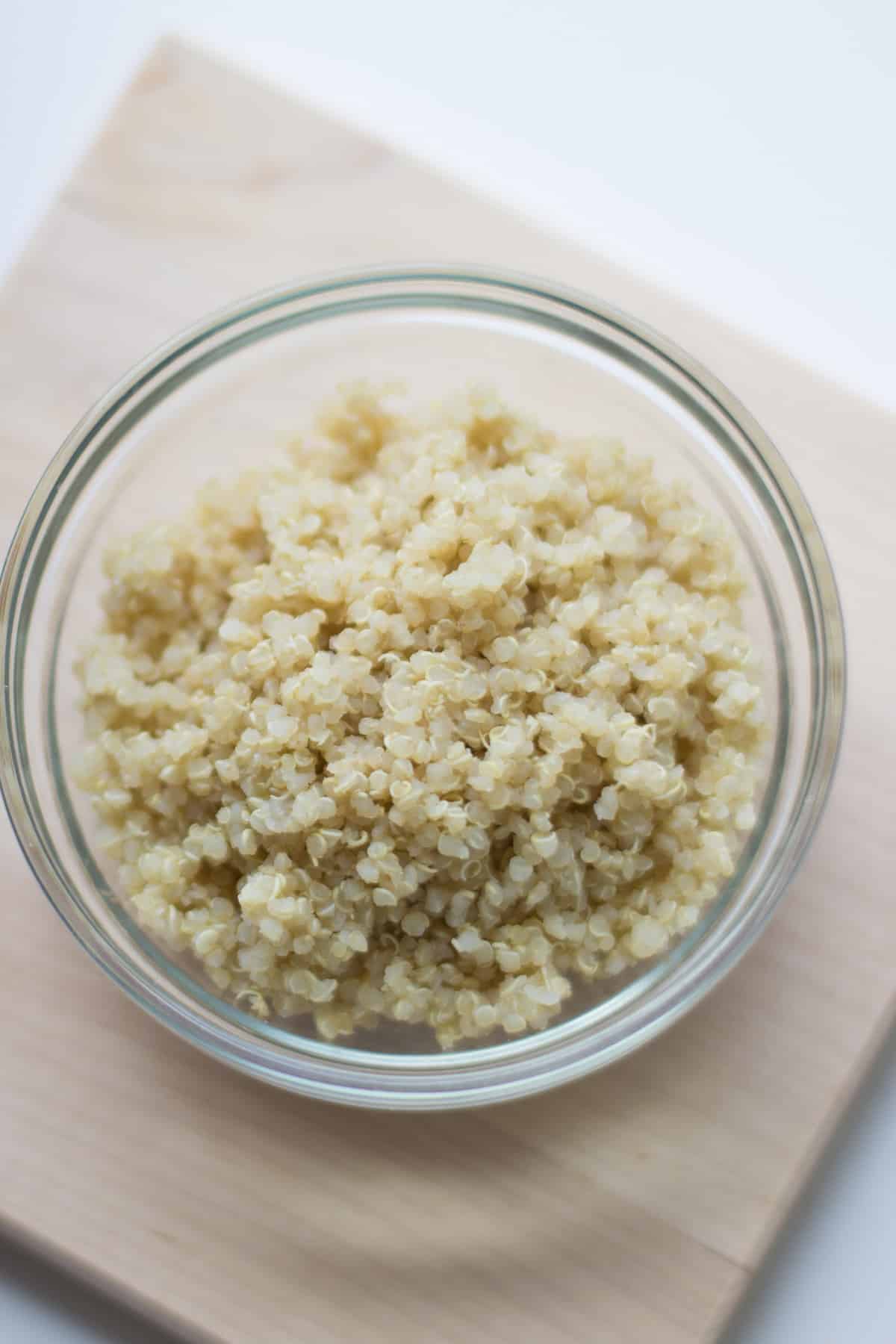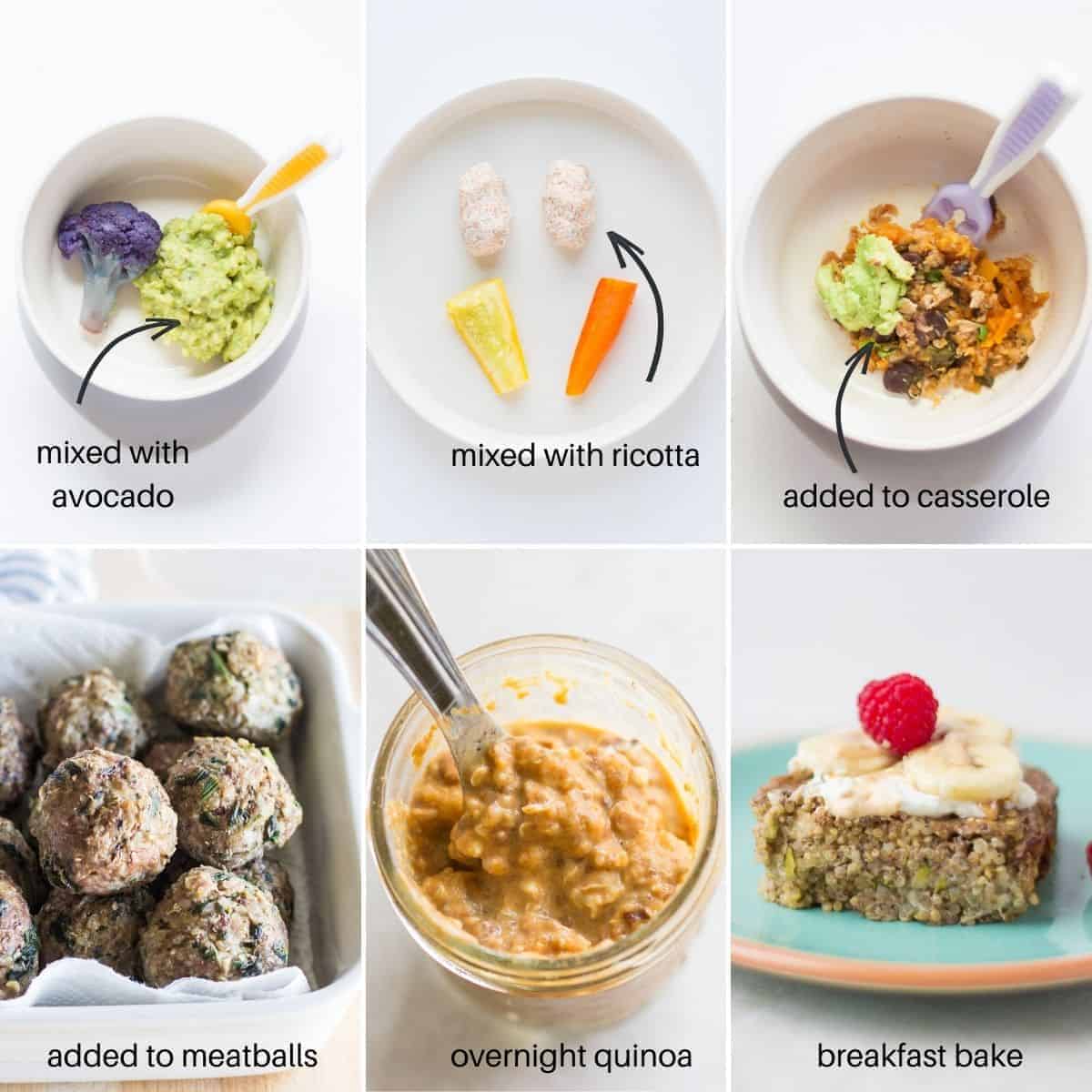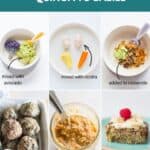This post may contain affiliate links. Please see our disclosure policy for more details.
Quinoa is one of the best first foods for babies! Here’s how to cook it perfectly every single time as well as some healthy and easy serving suggestions.

When can babies eat quinoa?
Quinoa can be offered to babies as soon as they’re ready to start solids, usually around 6 months. It’s important to remember that your baby is unique and that rather than going by the calendar, you need to make sure your baby is DEVELOPMENTALLY ready to start solids.
If you’re unsure, be sure to grab my FREE handout!
Health Benefits
First, quinoa is actually a seed rather than a grain, it’s used as and substituted for grains because it’s cooked like one.
Quinoa is unique in that it is a complete protein. It is one of the rare non-animal products that provides all 9 essential amino acids. What does this mean?
Many plant foods have incomplete proteins bc they lack one or more of the essential amino acids. Therefore, you must consume it with another source that contains the amino acid that’s missing. Both combined are called “complementary proteins.”
Food pairings that make up the complementary proteins are:
- Legumes with grains, seeds, nuts, or dairy. Example: lentil chili with whole wheat bread
- Grains with dairy. Example: savory baked oatmeal with milk
- Dairy with nuts/seeds, legumes. Examples: Yogurt with hemp seeds
However, this isn’t to say that you have to be intentional about pairing them together at each meal. As long as you eat a well-balanced diet with a variety of plant foods throughout the day, you should be set.
In addition to quinoa being a complete protein, it is also an excellent source of…(to name a few):
- Iron: Here’s an entire post dedicated to this essential nutrient for babies!
- Magnesium: Helps relax muscles and blood vessels
- Fiber: We all know why we need fiber! Regularity is key! 😉
- Omega 3 and 6 fatty acids: Necessary for optimal brain development
- Manganese: An essential mineral required to manufacture enzymes necessary for the metabolism of proteins and fats; has important antioxidant properties
- Phosphorous and Copper: Necessary for bone-building
Related Post: Best First foods for babies
Is quinoa safe for babies?
You don’t need to introduce it with caution as it’s neither a choking hazard nor one of the top allergens. It’s a great alternative to rice (which you do want to avoid offering regularly due to arsenic) and wheat, a top allergen.
How to cook
On the stovetop

- Rinse in a fine mesh strainer.
- Add quinoa to a pot along with liquid of choice.
- Bring to a boil.
- Simmer, covered for about 15-20 minutes, until soft and fluffy.
In the Rice cooker
Treat it like rice! The quinoa to water ratio remains the same. Stir so it doesn’t stick to the bottom. Close the lid and press start or the button used for cooking white rice, if you have it.
Once done, remove from the rice cooker within 15 minutes so it doesn’t get too mushy from the residual steam.
Expert Tips

- Rinse first to get rid of its natural coating, called saponins, which can make the cooked grain taste bitter.
- The perfect quinoa to water ratio is 1 cup dry quinoa to 2 cups water. This will yield about 3 cups cooked.
- Don’t overcook. Generally, it should take about 15-20 minutes to achieve that perfectly fluffy texture.
- Once cooked, cover and let it stand for 5 minutes or so. This will allow for the quinoa to steam, making it extra fluffy.
- If you want to cook more than 1 cup of quinoa to enjoy throughout the week or freeze, cook in batches to minimize the chances of overcooking. Otherwise you will end up with overcooked, mushy product.
- Boost flavor! Feel free to use broth instead of water, and once cooked, stir in some oil or butter, herbs and spices (hold off if intending to enjoy in many different ways).
Serving Suggestions

So what does it taste like? It is light, fluffy, and slightly nutty.
While you can totally serve it on its own, I dare not do this. Well, I have before, and I watched in horror as the tiny grains flew everywhere.
So while messy eating is an important part of learning to self feed, we can use other foods for this ;). The key to serving quinoa is to mix it into something that’s thick so it will be easier to scoop with hands.
Here are some suggestions:
- yogurt
- mashed avocado
- mashed starchy vegetables – like sweet potatoes, butternut squash
- beans and legumes, like lentils – you can even shape into balls to make it even easier to eat
- other thicker grains – like oatmeal, rice
You can also add to baked goods – like these vegan vegetable muffins, sweet potato patties, and chickpea patties.
Enjoy this delicious, versatile grain for breakfast, lunch, and dinner!
Quinoa Porridge
If you’re doing purees, you can go a step further and blend cooked quinoa. Now you have a nutritious baby cereal and a blank canvas where you can mix in all kinds of toppings to invite variety and texture!
Here’s how to make ANY quinoa baby cereal as well as this easy quinoa breakfast porridge.
Frequently Asked Questions
You don’t unless that’s what you feel comfortable doing. Yes, I am a big proponent of baby led weaning, but even more so an advocate for do what feels right for YOU!
Start with puree and because it is important to move forward with texture by 9 months of age, gently remind and challenge yourself and your baby to try nonpureed foods.
If you feel like you’re stuck on purees, here’s some guidance.
Did you know that there are over 1000 varieties of quinoa?! The three main varieties you’ll find in the store are white, red, and black. They are all safe and all great options.
I recommend starting with white quinoa as it has the mildest flavor and softest texture. The other two have a more earthy, stronger flavor, as well as a toothsome texture.
To minimize the chances of it tasting bitter once cooked, it is best to do so. Having said this, I’ve been purchasing from Costco for years now, and my family hasn’t noticed a difference. If anything, the unrinsed quinoa has a nuttier flavor.
Texture wise, I’ve found rinsing does make it a bit softer. So I leave it up to you. Perhaps do a little experiment to see!
Allow for quinoa to cool completely. Transfer to an airtight container and keep in the fridge for up to 5 days.
Yes! Again, cool completely, and divide into individual portions. Place in freezer-safe bags or containers and freeze for up to 2 months. Thaw in the fridge overnight.
Quinoa recipes for babies
- Quinoa Wraps
- Korean beef and broccoli quinoa
- Instant Pot Multigrain Rice
- Baked quinoa and mushroom beef meatballs
- Vegan vegetable quinoa muffins
- Overnight quinoa
- Chicken quinoa spinach casserole
- One pot parmesan pumpkin quinoa
- Vegetarian roasted cauliflower lasagna
Did you make this recipe? Leave a rating below and let me know how you liked the recipe! Your feedback means so much to me!

How to cook quinoa for babies
Ingredients
- 1 cup dry quinoa (195g)
- 2 cups water, broth, or milk of choice
Instructions
- Add quinoa to a fine mesh strainer and rinse under cool water. Drain.
- In a medium pot, add quinoa and liquid of choice.
- Stir and bring to a boil. Reduce heat to low, cover, and simmer for 15 minutes.
- Remove from heat and let it stand for 5 minutes, covered. Fluff with a fork.














